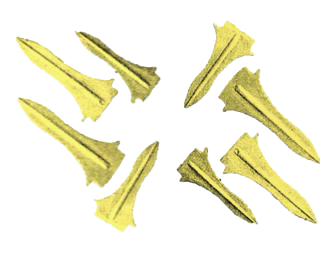In modern times the use of money in the form of banknotes and coins or in electronic form has become a habitual experience and we cannot conceive its absence in our every-day life. Money, however, had a complex evolution over time.

The oldest coin discovered in Romania,
at Histria, in 1955:
electrum hekte, Cyzicus, VIth century, BC
History tells us that the first circular-shaped coins, with a standard weight guaranteed by a state authority, appeared approximately 2,600 years ago in Lydia, a kingdom in Asia Minor (modern-day Turkey), that exploited gold and silver ores. Lydian King Croesus’s legendary wealth was based on precious metal mines, as told by “the father of history”, Herodotus.
It is not known for certain if King Croesus was the first to mint coins, but we do know that in the same period the Greek city Cyzicus (in modern-day Turkey) issued coins made of electrum (native gold which contains a large amount of silver). These coins were widely used, some even reaching our country, at Histria (Istros).
The pre-coin period can be reconstituted by analyzing the exchange means used by primitive communities, currently located in isolated areas. It has been observed that the concept of value is different from one community to another. The inhabitants of Yap island (located in the Pacific Ocean), still use, occasionally, stone wheel-shaped coins whose size vary from a few centimeters to four meters; their size, design and quality is a good indicator for their value. Other primitive communities of the Pacific area or in Africa had used until recently dog fangs, cowrie shells, pearls, coffee beans, rings of different sizes.
Four thousand years ago, in the Middle East, advanced Sumerian and Babylonian societies moved from barter to the payment of goods and services using copper, precious metal pieces, or ingots. These items had a significant advantage: they were not perishable and were easily transportable. One of the oldest code of laws in the world, Hammurabi's Code (over 3,760 years old), shows that Babylonian society was familiar with financial activities and the notion of money, even though in a primitive pre-coin form. Development in long-distance trade forcefully led to the diversification of pre-monetary copper, silver and electrum items in the Middle East and Europe.

Perșinari hoard
Archaeological studies and accidental discoveries show that on the territory of our country primitive money were used since c. 1,500-1,400 BC. In this respect stands testimony the hoard discovered in 1962 at Perșinari (Dâmbovița County) consisting of dagger-shaped gold pieces. This hoard aroused the interest of specialists worldwide that deemed it an import from Mycenae (major Greek civilization center) or on the contrary, thought it was a product made of gold mined locally.
The recovery story of this hoard is however less known. Thus, in 1963, 11 pieces of the hoard were brought by the authorities of the time at the Târgoviște Branch of the National Bank of Romania and then sent to headquarters, with the recommendation to be melted. Intrigued by the gold pieces’ unusual shape, Ion M. Brutus, Director of Precious Metals Department, delayed the items’ melting and requested the opinion of the renowned numismatist Octavian Iliescu, researcher at the Numismatic Cabinet of the Romanian Academy Library at that time. Therefore, the inter-institutional cooperation between specialists helped save this spectacular discovery and subsequently enabled its presentation to the public in 1964, at the Numismatic Cabinet of the Romanian Academy Library. The hoard was for the first time admired by the public abroad in a big exhibition themed Treasures of Ancient Art in Romania, organized throughout 1970-1971 in Paris, Stockholm, Gothenburg and London by the Office for Organizing Exhibitions. On returning home, Perşinari hoard was loaned to the National History Museum of Romania where it had remained exhibited to this day.

Gold coin with the Persinari hoard issued by the National Bank of Romania in 2005
More than 2,700 years ago, the establishment of Greek cities on the Black Sea shore and the increase of exchanges with the local population led to the widespread appearance of bronze pre-money items. These coin forerunners of different shapes were produced by molding in the Greek cities with the purpose of improving trade relations.

Arrowhead primitive money
The most widely spread primitive bronze money used in our country 2,600 years ago, was the arrowhead, named after its shape. Treasures composed of hundreds of arrowheads were brought to daylight in Dobruja, revealing the economic role of primitive money of this type.
Rarer and less known is the dolphin whose shape recalls the important role of the Black Sea for local communities and Greek traders settled on the coastline. The miniature bow and arrow is part of the same primitive money category.

Dolphin primitive money (left) | Bow and arrow primitive money (right)
The shapes of pre-coin items are not randomly chosen; their symbolism denotes power (the arrowhead) and the particularities of the area (the dolphin). Production and usage of pre-money items ceased after the issuance of the first coins in our country by the Greek town of Histria two and a half millennia ago.
The collections of the Museum of the National Bank of Romania include all three types of primitive money presented. Within the permanent exhibition located in the Marble Hall of the Old Palace of the National Bank visitors can admire two examples of arrowheads, forerunner of the archaic coins put into circulation by the city of Histria.

The oldest coin issued on the teritory of our country, Histrian silver didrachm